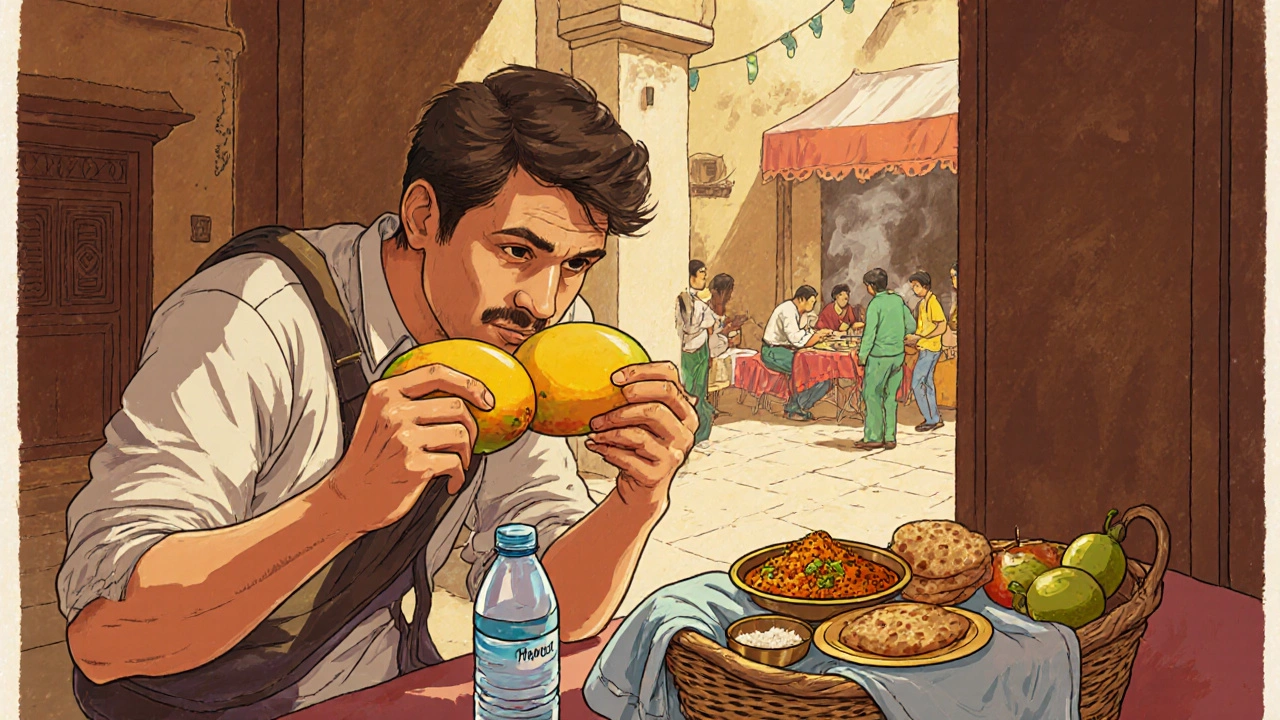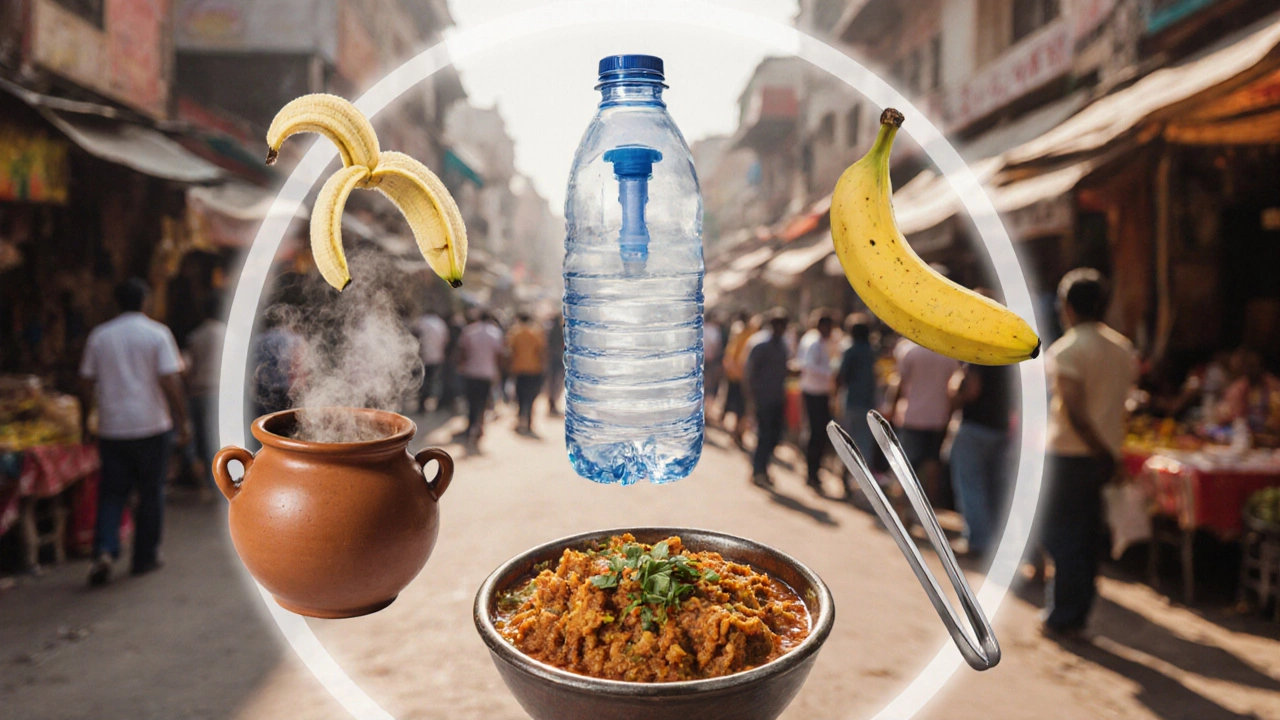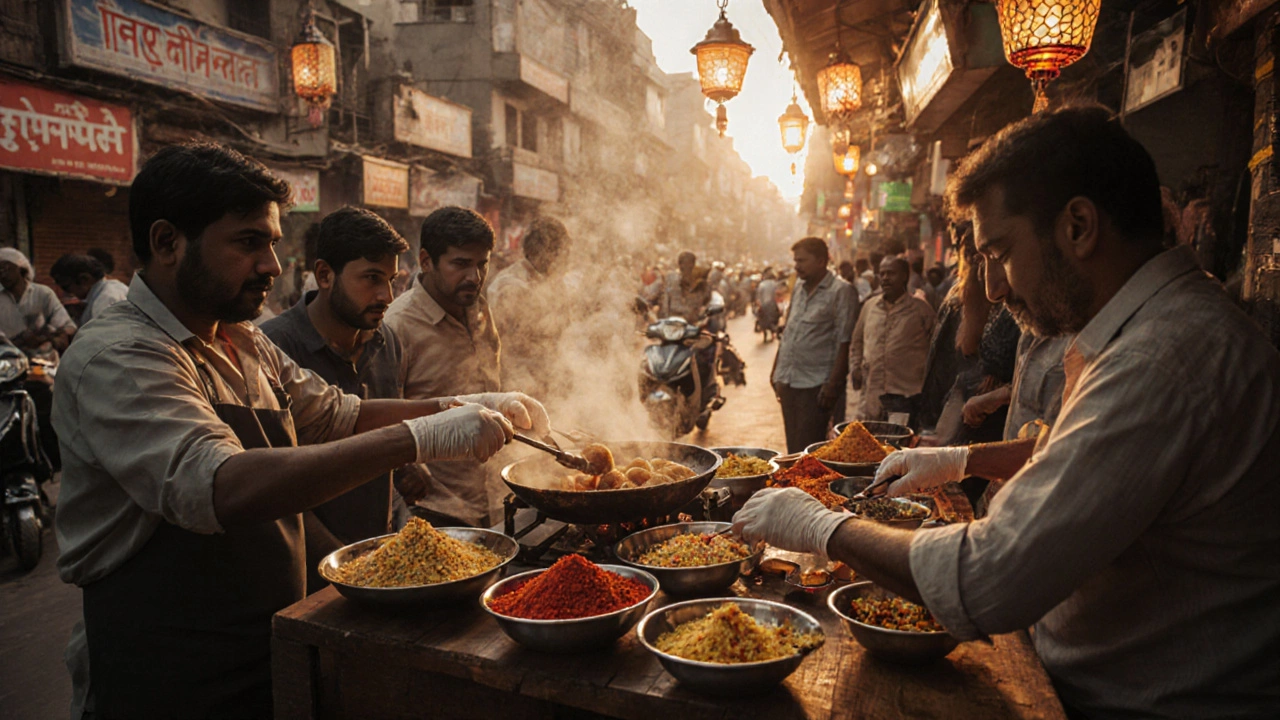India Food Safety Checker
Is Your Food Safe in India?
Check if your meal or drink meets the safe eating guidelines from the article.
If you’ve ever dreamed of tasting spicy chaat in Delhi, savoring butter chicken in Punjab, or biting into a crispy dosa in Chennai, you’re not alone. But the fear of getting sick from food in India is real-and it’s the number one reason travelers cut their trips short. The good news? You don’t have to avoid Indian food to stay healthy. With a few smart choices, you can eat your way through India without ending up in a hotel room with stomach cramps.
Stick to Hot, Fresh, and Well-Cooked Food
The golden rule? If it’s hot, it’s safe. Bacteria that cause traveler’s diarrhea can’t survive at high temperatures. That means a freshly made samosa straight out of the oil, a steaming plate of dal tadka, or a piping hot biryani from a busy stall is far safer than something sitting out at room temperature.
Look for stalls where food is cooked to order. A crowded vendor isn’t just popular-it’s a sign that food turns over fast. If you see a pile of cooked food sitting under a cloth for hours, walk away. Even if it looks clean, the longer food sits, the more time bacteria have to multiply.
Street food isn’t the enemy. In fact, some of the safest and tastiest meals in India come from street vendors. The key is watching how it’s made. If the vendor uses gloves or tongs to handle food, uses clean utensils, and serves it hot off the flame, you’re in good shape. Avoid anything that’s been sitting under a fly cover for more than 10 minutes.
Drink Only Bottled or Filtered Water
Tap water in India-even in luxury hotels-isn’t safe to drink. That includes ice. Ice cubes are made from tap water, and they’re one of the most common causes of stomach bugs. Always ask for drinks without ice, or bring your own reusable bottle with a built-in filter.
Look for sealed bottles from trusted brands like Bisleri, Aquafina, or Kinley. Check the cap for a tamper-proof seal. If it’s broken or missing, don’t risk it. Even if the bottle looks new, it could have been refilled. Many travelers carry a portable water purifier like a SteriPEN or a LifeStraw bottle-they’re lightweight and work wonders in rural areas.
Hot tea and coffee are generally safe because boiling kills bacteria. A cup of masala chai from a busy roadside stall? Usually fine. Just make sure it’s served hot. Cold milk-based drinks like lassi or milkshakes? Skip them unless you’re sure the milk was pasteurized and kept cold.
Peel It or Skip It
Fruits and vegetables are healthy, but they’re also high-risk if washed in contaminated water. Avoid raw salads, unpeeled fruits, and raw herbs like cilantro or mint in sauces.
Instead, choose fruits you can peel yourself: bananas, oranges, mangoes, papayas, and pomegranates. Even if the peel looks clean, wash it with bottled water before peeling. Bacteria on the outside can transfer to your fingers and then to the fruit inside.
Vegetables like cucumbers, tomatoes, and lettuce? Skip them unless you’re eating at a reputable hotel or restaurant that sources its produce carefully. Many travelers bring a small bottle of food-safe water purifier drops to rinse produce if they’re staying in a homestay or guesthouse.

Choose the Right Street Food
Not all street food is risky. Some of India’s most beloved snacks are naturally safe when prepared correctly.
- Chaat (like pani puri, bhel puri): Safe if the water used is filtered and the tamarind chutney is fresh. Avoid stalls where the water tank looks cloudy or the chutneys sit uncovered.
- Dosa and idli: Fermented rice and lentil batter is naturally resistant to harmful bacteria. These are usually fried or steamed fresh-perfect choices.
- Samosas and pakoras: Deep-fried in hot oil. The high heat kills germs. Just make sure they’re crispy, not soggy.
- Roti and paratha: Freshly made flatbreads cooked on a hot griddle. Always ask for them hot off the tawa.
- Grilled corn or kebabs: Look for meat that’s charred on the outside and cooked through. Avoid anything that looks pink or underdone.
Steer clear of:
- Raw fruit juices (unless you see them squeezed fresh from whole fruit right in front of you)
- Unpasteurized cheese or yogurt (especially in rural areas)
- Food served with wet hands or on dirty plates
What About Dairy?
India is famous for its dairy-ghee, paneer, lassi, and kulfi. But not all dairy is created equal.
Paneer (fresh cheese) is usually safe if it’s made from pasteurized milk and served hot. Look for it in curries or grilled dishes. Avoid plain paneer that’s been sitting out.
Yogurt and lassi? Only drink them if they’re refrigerated and served cold. In hot weather, even a few hours at room temperature can turn good yogurt into a breeding ground for bacteria. Stick to brands like Amul or Mother Dairy-they’re pasteurized and widely trusted.
Ghee (clarified butter) is one of the safest dairy products. It’s been cooked down to remove water and milk solids, making it shelf-stable and bacteria-resistant. Use it to flavor rice or roti-it’s a flavor booster and a safety net.

What to Do If You Do Get Sick
Even with all the precautions, stomach issues can still happen. It’s not always food poisoning-it could be a change in diet, stress, or just your body adjusting.
Here’s what to do:
- Stay hydrated. Drink bottled water with a pinch of salt and sugar, or use oral rehydration salts (ORS). These are sold everywhere in India.
- Stick to bland food: rice, toast, bananas, boiled potatoes. Avoid spicy, fatty, or dairy-heavy meals until you feel better.
- Carry loperamide (Imodium) for short-term relief, but don’t use it if you have a fever or bloody stool.
- If symptoms last more than 48 hours, or if you have a fever, chills, or vomiting, see a doctor. Many cities have clinics for travelers.
Most cases clear up in 1-3 days. Don’t panic. But don’t ignore warning signs either.
Local Tips from People Who Live There
Ask Indian locals what they eat-and you’ll get the best advice. Most Indians avoid raw vegetables and drink only boiled or bottled water. They eat street food daily, but they know exactly which stalls are clean.
In Delhi, locals swear by the dhabas near the metro stations. In Mumbai, the best vada pav comes from the same stall on Marine Drive for 40 years. In Jaipur, the best dal baati churma is served hot from a clay oven.
Follow the locals. If you see a group of office workers lining up for a snack, it’s probably safe. If the place is empty except for tourists, it’s a red flag.
Final Checklist: Eat Safe, Eat Well
Before you bite into anything in India, ask yourself:
- Is it hot? If yes, you’re probably fine.
- Is it peeled or cooked? If yes, skip the raw stuff.
- Is the water sealed? Bottled only. No exceptions.
- Is the vendor clean? Gloves, tongs, clean surfaces? Good sign.
- Is it busy? Crowds mean fast turnover. Fast turnover means fresh food.
India’s food is one of its greatest gifts. Don’t let fear rob you of masala chai at sunrise, spicy kebabs at dusk, or sweet jalebi after a temple visit. With these simple rules, you’ll eat like a local-and stay healthy while doing it.
Can I eat street food in India without getting sick?
Yes, you can eat street food safely in India if you follow basic rules: choose stalls where food is cooked fresh and served hot, avoid anything sitting out for more than 10 minutes, and make sure the vendor uses clean utensils. Popular stalls with long lines are usually the safest because food turns over quickly.
Is bottled water safe in India?
Yes, sealed bottled water from brands like Bisleri, Aquafina, or Kinley is safe. Always check the tamper-proof seal on the cap. Avoid refilled bottles or water sold in unsealed containers. Even ice in drinks is made from tap water, so ask for drinks without ice.
Can I eat fruit in India?
Only eat fruit you can peel yourself, like bananas, oranges, or mangoes. Wash the peel with bottled water before peeling. Avoid pre-cut fruit, salads, or any fruit served with water-these are often washed in contaminated water.
Is milk or yogurt safe in India?
Pasteurized dairy from trusted brands like Amul or Mother Dairy is safe if kept cold. Avoid homemade yogurt or lassi unless you’re sure it’s refrigerated. Fresh paneer is usually fine if served hot in a curry. Never drink raw milk.
What should I do if I get sick from food in India?
Drink plenty of bottled water and use oral rehydration salts. Eat bland foods like rice, toast, and bananas. Avoid spicy, fatty, or dairy-heavy meals. Use loperamide only for short-term relief. If you have a fever, bloody stool, or symptoms last more than two days, see a doctor. Most cases clear up in 1-3 days.
